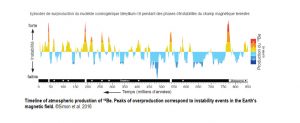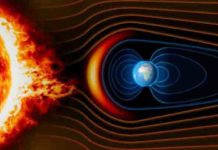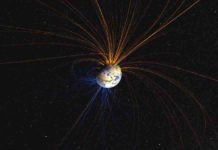
Past variations in the strength of the Earth’s magnetic field are reflected by the production of isotopes in the atmosphere. Researchers from the CNRS, Aix Marseille Université and the French Alternative Energies and Atomic Energy Commission CEA have used an isotope extracted from marine sediments to identify such geomagnetic excursions over a particularly long period. Beryllium-10 provides a timeline stretching back over the past 850,000 years, during which its concentration fluctuated according to the strength of Earth’s magnetic field. The work, published in Journal of Geophysical Research: Solid Earth, provides a new tool to study past variations in the Earth’s magnetic field and its behavior in the future.
The beryllium isotope 10Be forms in the atmosphere under the action of cosmic rays, which are partially deflected by the Earth’s magnetic field. The strength of the field therefore affects the production of 10Be. The isotope is washed out of the atmosphere by rain shortly after it forms and sticks to mineral grains that settle onto the sea floor. Three sediment cores were extracted from the bottom of the Indian and Pacific oceans and analyzed with the aim of comparing 10Be concentrations with those of 9Be, which originates in the Earth’s crust. This ratio was used to estimate the atmospheric production rate of 10Be at the millennial scale over a period of 850,000 years. The production rate was indeed found to change in line with variations in the magnetic field, which were already known from paleomagnetic methods whose reliability needed testing.
Episodes of overproduction of 10Be correspond to collapses of the Earth’s magnetic field, including those associated with its most recent reversal known, the Brunhes-Matuyama reversal 770,000 years ago. Falls in the strength of the magnetic field also coincide with excursions, failed reversals in which the poles finally return to their initial position. Such phenomena occur every 20,000 to 50,000 years, with the most recent one taking place 41,500 years ago. After several attempted reversals, the Earth’s magnetic field might well resume this behavior. Indeed, direct measurements of the magnetic field reveal a rapid decrease in the field, initiated 2,500 years ago. If this continues in the future, it could create conditions favorable to a new excursion, or even a reversal, in two or three thousand years’ time.
Reference:
Quentin Simon et al. AuthigenicBe/Be ratio signatures of the cosmogenic nuclide production linked to geomagnetic dipole moment variation since the Brunhes/Matuyama boundary, Journal of Geophysical Research: Solid Earth (2016). DOI: 10.1002/2016JB013335
Note: The above post is reprinted from materials provided by CNRS.









